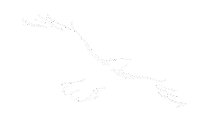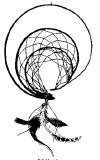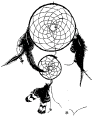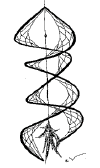The Soul of the Indian
Eastman, Charles Alexander (1911)
VI. ON
THE BORDER-LAND OF SPIRITS
Death and Funeral Customs. The Sacred Lock of Hair.
Reincarnation and the Converse of Spirits. Occult and Psychic Powers. The
Gift of Prophecy.
THE attitude of the Indian toward death, the test and
background of life, is entirely consistent with his character and
philosophy. Death has no terrors for him; he meets it with simplicity and
perfect calm, seeking only an honorable end as his last gift to his family
and descendants. Therefore, he courts death in battle; on the other hand, he
would regard it as disgraceful to be killed in a private quarrel. If one be
dying at home, it is customary to carry his bed out of doors as the end
approaches, that his spirit may pass under the open sky.
Next to this, the matter that concerns him most is the
parting with his dear ones, especially if he have any little children who
must be left behind to suffer want. His family affections are strong, and he
grieves intensely for the lost, even though he has unbounded faith in a
spiritual companionship.
The outward signs of mourning for the dead are far more
spontaneous and convincing than is the correct and well-ordered black of
civilization men and women among us loosen their hair and cut it according
to the degree of relationship or of devotion. Consistent with the idea of
sacrificing all personal beauty and adornment, they trim off likewise from
the dress its fringes and ornaments, perhaps cut it short, or cut the robe
or blanket in two. The men blacken their faces, and widows or bereaved
parents sometimes gash their arms and legs till they are covered with blood.
Giving themselves up wholly to their grief, they are no longer concerned
about any earthly possession, and often give away all that they have to the
first comers, even to their beds and their home. Finally, the wailing for
the dead is continued night and day to the point of utter voicelessness; a
musical, weird, and heart-piercing sound, which has been compared to the,
"keening" of the Celtic mourner.
The old-time burial of the Plains Indians was upon a
scaffold of poles, or a platform among the boughs of a tree -- their only
means of placing the body out of reach of wild beasts, as they had no
implements with which to dig a suitable grave. It was prepared by dressing
in the finest clothes, together with some personal possessions and
ornaments, wrapped in several robes, and finally in a secure covering of
raw-hide. As a special mark of respect, the body of a young woman or a
warrior was sometimes laid out in state in a new teepee, with the usual
household articles and even with a dish of food left beside it, not that
they supposed the spirit could use the implements or eat the food but merely
as a last tribute. Then the whole people would break camp and depart to a
distance, leaving the dead alone in an honorable solitude.
There was no prescribed ceremony of burial, though the
body was carried out with more or less solemnity by selected young men, and
sometimes noted warriors were the pall-bearers of a man of distinction. It
was usual to choose a prominent with a commanding outlook for the last
resting-place of our dead. If a man were slain in battle, it was an old
custom to place his body against a tree or rock in a sitting position,
always facing the enemy, to indicate his undaunted defiance and bravery,
even in death.
I recall a touching custom among us, which was designed to
keep the memory of the departed near and warm in the bereaved household. A
lock of hair of the beloved dead was wrapped in pretty clothing, such as it
was supposed that he or she would like to wear if living. This "spirit
bundle," as it was called, was suspended from a tripod, and occupied a
certain place in the lodge which was the place of honor. At every meal time,
a dish of food was placed under it, and some person of the same sex and age
as the one who was gone must afterward be invited in to partake of the food.
At the end of a year from the time of death, the relatives made a public
feast and gave away the clothing and other gifts, while the lock of hair was
interred with appropriate ceremonies.
Certainly the Indian never doubted the immortal nature of
the spirit or soul of man, but neither did he care to speculate upon its
probable state or condition in a future life. The idea of a "happy
hunting-ground" is modern and probably borrowed, or invented by the white
man. The primitive Indian was content to believe that the spirit which the
"Great Mystery" breathed into man returns to Him who gave it, and that after
it is freed from the body, it is everywhere and pervades all nature, yet
often lingers near the grave or "spirit bundle" for the consolation of
friends, and is able to hear prayers. So much of reverence was due the
disembodied spirit, that it was not customary with us even to name the dead
aloud.
It is well known that the American Indian had somehow
developed occult power, and although in the latter days there have been many
impostors, and, allowing for the vanity and weakness of human nature, it is
fair to assume that there must have been some even in the old days, yet
there are well-attested instances of remarkable prophecies and other mystic
practice.
A Sioux prophet predicted the coming of the white man
fully fifty years before the event, and even described accurately his
garments and weapons. Before the steamboat was invented, another prophet of
our race described the "Fire Boat" that would swim upon their mighty river,
the Mississippi, and the date of this prophecy is attested by the term used,
which is long since obsolete. No doubt, many predictions have been colored
to suit the new age, and unquestionably false prophets, fakirs, and
conjurers have become the pest of the tribes during the transition period.
Nevertheless, even during this period there was here and there a man of the
old type who was implicitly believed in to the last.
Notable among these was Ta-chank-pee Ho-tank-a, or His War
Club Speaks Loud, who foretold a year in advance the details of a great
war-party against the Ojibways. There were to be seven battles, all
successful except the last, in which the Sioux were to be taken at a
disadvantage and suffer crushing defeat. This was carried out to the letter.
Our people surprised and slew many of the Ojibways in their villages, but in
turn were followed and cunningly led into an ambush whence but few came out
alive. This was only one of his remarkable prophecies.
Another famous "medicine-man" was born on the Rum River
about one hundred and fifty years ago, and lived to be over a century old.
He was born during a desperate battle with the Ojibways, at a moment when,
as it seemed, the band of Sioux engaged were to be annihilated. Therefore
the child's grandmother exclaimed: "Since we are all to perish, let him die
a warrior's death in the field!" and she placed his cradle under fire, near
the spot where his uncle and grandfathers were fighting, for he had no
father. But when an old man discovered the new-born child, he commanded the
women to take care of him, "for," said he, "we know not how precious the
strength of even one warrior may some day become to his nation!"
This child lived to become great among us, as was
intimated to the superstitious by the circumstances of his birth. At the age
of about seventy-five years, he saved his band from utter destruction at the
hands of their ancestral enemies, by suddenly giving warning received in a
dream of the approach of a large war-party. The men immediately sent out
scouts, and felled trees for a stockade, barely in time to meet and repel
the predicted attack. Five years later, he repeated the service, and again
saved his people from awful slaughter. There was no confusion of figures or
omens, as with lesser medicine-men, but in every incident that is told of
him his interpretation of the sign, whatever it was, proved singularly
correct.
THE GREAT MYSTERY -
2
THE FAMILY ALTAR -
2
CEREMONIAL AND SYMBOLIC WORSHIP
-
2
BARBARISM AND THE MORAL CODE
-
2
UNWRITTEN SCRIPTURES
-
2
ON THE BORDERLAND OF SPIRITS
-
2
White Eagle Soaring: Dream Dancer of the 7th Fire







 Get
a course to promote your business online, explode your sales
Get
a course to promote your business online, explode your sales Get
software to promote your business online in less time
Get
software to promote your business online in less time Get
software to streamline your business and run it hands free.
Get
software to streamline your business and run it hands free.